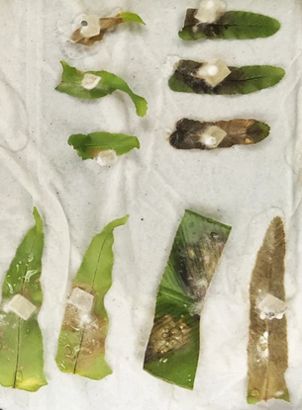

www.cam.ac.uk/jobs/post-do...
www.schornacklab.net


www.cam.ac.uk/jobs/post-do...
www.schornacklab.net

🌾 The developing leaf of the wild grass Brachypodium distachyon at single-cell resolution
👉 doi.org/10.1101/2025...
A 70k-cell single-cell RNA-seq atlas of the developing grass leaf—from the shoot meristem to mature leaf tissues. @cerealcell.bsky.social @lbmountain.bsky.social

🌾 The developing leaf of the wild grass Brachypodium distachyon at single-cell resolution
👉 doi.org/10.1101/2025...
A 70k-cell single-cell RNA-seq atlas of the developing grass leaf—from the shoot meristem to mature leaf tissues. @cerealcell.bsky.social @lbmountain.bsky.social
🔥New results support a conserved three-gene module and master regulator for nutrient-responsive intracellular accommodation of fungal symbionts🤯
Check the nice thread below👇🏼
#plantscience
doi.org/10.1101/2025...
Here, we identified and functionally validated a novel master regulator of intracellular symbioses!
A thread ...
#PlantScience

🔥New results support a conserved three-gene module and master regulator for nutrient-responsive intracellular accommodation of fungal symbionts🤯
Check the nice thread below👇🏼
#plantscience
doi.org/10.1101/2025...
Here, we identified and functionally validated a novel master regulator of intracellular symbioses!
A thread ...
#PlantScience

doi.org/10.1101/2025...
Here, we identified and functionally validated a novel master regulator of intracellular symbioses!
A thread ...
#PlantScience
#PhDSuccess #PlantScience #PhDone #ScientificAchievement

#PhDSuccess #PlantScience #PhDone #ScientificAchievement
🔗 doi.org/10.1093/molbev/msaf240
#evobio #molbio #PlantSky

🔗 doi.org/10.1093/molbev/msaf240
#evobio #molbio #PlantSky
🔗 doi.org/10.1093/molbev/msaf241
#evobio #molbio #PlantSky

🔗 doi.org/10.1093/molbev/msaf241
#evobio #molbio #PlantSky
🔗 doi.org/10.1093/molbev/msaf247
#evobio #molbio #PlantSky

🔗 doi.org/10.1093/molbev/msaf247
#evobio #molbio #PlantSky
In @nature.com, @arnausebe.bsky.social and colls launch the Biodiversity Cell Atlas, a global effort to map eukaryotic cell diversity using single-cell & genomic data.
drive.google.com/file/d/1G4zZ... @crg.eu @ibe-barcelona.bsky.social

In @nature.com, @arnausebe.bsky.social and colls launch the Biodiversity Cell Atlas, a global effort to map eukaryotic cell diversity using single-cell & genomic data.
drive.google.com/file/d/1G4zZ... @crg.eu @ibe-barcelona.bsky.social
Today, we report the discovery of telomerase homologs in a family of antiviral RTs, revealing an unexpected evolutionary origin in bacteria.
www.biorxiv.org/content/10.1...

Today, we report the discovery of telomerase homologs in a family of antiviral RTs, revealing an unexpected evolutionary origin in bacteria.
www.biorxiv.org/content/10.1...
🌿🌿Our article on fern immunity has been peer-reviewed 🌿🌿
Thanks to @madeleinebaker.bsky.social @kellerjeanphd.bsky.social @maximebonhomme.bsky.social @pierremarcdelaux.bsky.social and @jacquet-chris.bsky.social
a quick thread 🧵 1/4

🌿🌿Our article on fern immunity has been peer-reviewed 🌿🌿
Thanks to @madeleinebaker.bsky.social @kellerjeanphd.bsky.social @maximebonhomme.bsky.social @pierremarcdelaux.bsky.social and @jacquet-chris.bsky.social
a quick thread 🧵 1/4
doi.org/10.1186/s129...
Congrats on this huge team effort to @baptistebio.bsky.social @madeleinebaker.bsky.social @kellerjeanphd.bsky.social @maximebonhomme.bsky.social @pierremarcdelaux.bsky.social

doi.org/10.1186/s129...
Congrats on this huge team effort to @baptistebio.bsky.social @madeleinebaker.bsky.social @kellerjeanphd.bsky.social @maximebonhomme.bsky.social @pierremarcdelaux.bsky.social
@jandevries.bsky.social
@watertoland.bsky.social
www.biorxiv.org/content/10.1...

@jandevries.bsky.social
@watertoland.bsky.social
www.biorxiv.org/content/10.1...

Neubauer et al. developed a Nostoc reporter strain enabling high-throughput quantitative monitoring of hormogonia differentiation in cyanobacteria as a response to biotic and abiotic factors.
🔗 doi.org/10.1093/jxb/...
#PlantScience 🧪 @peterszovenyi.bsky.social

Neubauer et al. developed a Nostoc reporter strain enabling high-throughput quantitative monitoring of hormogonia differentiation in cyanobacteria as a response to biotic and abiotic factors.
🔗 doi.org/10.1093/jxb/...
#PlantScience 🧪 @peterszovenyi.bsky.social


doi.org/10.1101/2025...
A thread 👇

doi.org/10.1101/2025...
A thread 👇
Mistletoe forms a strong attachment to the host already at the seedling stage by combining an interlocking mechanism with the hypocotyl, forming a bridge-like structure that strengthens the parasite–host connection - Teixeira-Costa et al.
🔗 doi.org/10.1093/jxb/...
#PlantScience 🧪

Mistletoe forms a strong attachment to the host already at the seedling stage by combining an interlocking mechanism with the hypocotyl, forming a bridge-like structure that strengthens the parasite–host connection - Teixeira-Costa et al.
🔗 doi.org/10.1093/jxb/...
#PlantScience 🧪
Great teamwork between @lrsv-toulouse.bsky.social and LGDP-Perpignan 😎🥳🌱
academic.oup.com/plcell/advan...

Great teamwork between @lrsv-toulouse.bsky.social and LGDP-Perpignan 😎🥳🌱
academic.oup.com/plcell/advan...



